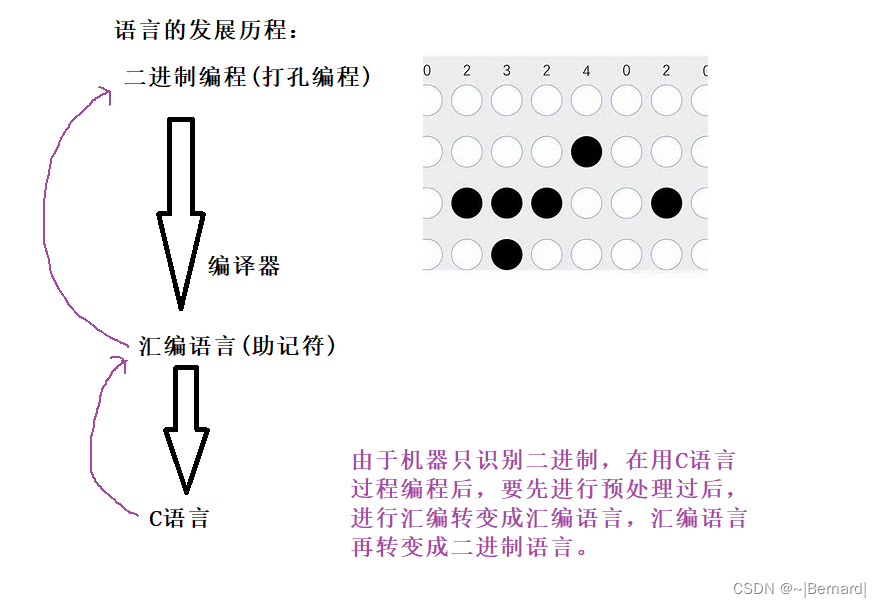1. 背景知识
1. 预处理(进行宏替换)
2. 编译(生成汇编)
3. 汇编(生成机器可识别代码)
4. 链接(生成可执行文件或库文件)
2. gcc如何完成
格式 gcc [选项] 要编译的文件 [选项] [目标文件]
[yyh@ecs-86081 lesson2]$ cat mytest.c #include<stdio.h> #define NUM 100 int main() { printf("hello world\n"); //printf("hello world\n"); //printf("hello world\n"); //printf("hello world\n"); //printf("hello world\n"); printf("hello world\n"); printf("NUM=%d\n",NUM); return 0; } [yyh@ecs-86081 lesson2]$ gcc mytest.c -o mytest [yyh@ecs-86081 lesson2]$ ll total 44 -rwxrwxr-x 1 yyh yyh 8408 Jul 27 22:19 mytest -rw-rw-r-- 1 yyh yyh 298 Jul 27 21:53 mytest.c [yyh@ecs-86081 lesson2]$ ./mytest hello world hello world NUM=100
预处理(进行宏替换)
[yyh@ecs-86081 lesson2]$ gcc -E mytest.c -o mytest.i [yyh@ecs-86081 lesson2]$ ll total 24 -rw-rw-r-- 1 yyh yyh 298 Jul 27 21:53 mytest.c -rw-rw-r-- 1 yyh yyh 16956 Jul 27 21:58 mytest.i·预处理功能主要包括宏替换,文件包含,条件编译,去注释等。
·预处理指令是以#号开头的代码行。
·实例: gcc –E mytest.c –o mytest.i
·选项“-E”,该选项的作用是让 gcc 在预处理结束后停止编译过程。
·选项“-o”是指目标文件,“.i”文件为已经过预处理的C原始程序。
编译(生成汇编)
在这个阶段中,gcc 首先要检查代码的规范性、是否有语法错误等,以确定代码的实际要做的工作,在检查无误后,gcc 把代码翻译成汇编语言。
用户可以使用“-S”选项来进行查看,该选项只进行编译,生成汇编代码。
实例: gcc –S mytest.i –o mytest.s[yyh@ecs-86081 lesson2]$ ll total 24 -rw-rw-r-- 1 yyh yyh 298 Jul 27 21:53 mytest.c -rw-rw-r-- 1 yyh yyh 16956 Jul 27 22:01 mytest.i [yyh@ecs-86081 lesson2]$ gcc -S mytest.i -o mytest.s [yyh@ecs-86081 lesson2]$ ll total 28 -rw-rw-r-- 1 yyh yyh 298 Jul 27 21:53 mytest.c -rw-rw-r-- 1 yyh yyh 16956 Jul 27 22:01 mytest.i -rw-rw-r-- 1 yyh yyh 567 Jul 27 22:04 mytest.s大家觉得编译器生成汇编就结束了吗?问:计算机可以直接执行汇编语言吗?汇编语言需要编译器吗?
答:计算机不可以直接执行汇编语言!汇编语言也有编译器。计算机只认识二进制。
汇编(生成机器可识别代码)
汇编阶段是把编译阶段生成的“.s”文件转成目标文件
可使用选项“-c”就可看到汇编代码已转化为“.o”的二进制目标代码了[yyh@ecs-86081 lesson2]$ ll total 28 -rw-rw-r-- 1 yyh yyh 298 Jul 27 21:53 mytest.c -rw-rw-r-- 1 yyh yyh 16956 Jul 27 22:01 mytest.i -rw-rw-r-- 1 yyh yyh 567 Jul 27 22:04 mytest.s [yyh@ecs-86081 lesson2]$ gcc -c mytest.s -o mytest.o [yyh@ecs-86081 lesson2]$ ll total 32 -rw-rw-r-- 1 yyh yyh 298 Jul 27 21:53 mytest.c -rw-rw-r-- 1 yyh yyh 16956 Jul 27 22:01 mytest.i -rw-rw-r-- 1 yyh yyh 1664 Jul 27 22:09 mytest.o -rw-rw-r-- 1 yyh yyh 567 Jul 27 22:04 mytest.s实例: gcc –c mytest.s –o mytest.o
汇编形成的二进制文件,虽然是二进制文件,并不可以直接执行,该文件叫作可重定向目标文件.
[yyh@ecs-86081 lesson2]$ ./mytest.o -bash: ./mytest.o: cannot execute binary file
链接(生成可执行文件或库文件)
在成功编译之后,就进入了链接阶段。为什么需要链接呢?因为我们要通过链接将自己的代码中的函数调用,外部数据和第三方提供库的方法关联起来。
实例: gcc mytest.o –o mytest[yyh@ecs-86081 lesson2]$ ll total 32 -rw-rw-r-- 1 yyh yyh 298 Jul 27 21:53 mytest.c -rw-rw-r-- 1 yyh yyh 16956 Jul 27 22:01 mytest.i -rwxrwxr-x 1 yyh yyh 1664 Jul 27 22:09 mytest.o -rw-rw-r-- 1 yyh yyh 567 Jul 27 22:04 mytest.s [yyh@ecs-86081 lesson2]$ gcc mytest.o -o mytest [yyh@ecs-86081 lesson2]$ ll total 44 -rwxrwxr-x 1 yyh yyh 8408 Jul 27 22:17 mytest -rw-rw-r-- 1 yyh yyh 298 Jul 27 21:53 mytest.c -rw-rw-r-- 1 yyh yyh 16956 Jul 27 22:01 mytest.i -rwxrwxr-x 1 yyh yyh 1664 Jul 27 22:09 mytest.o -rw-rw-r-- 1 yyh yyh 567 Jul 27 22:04 mytest.s
为什么C程序的翻译是上面这个过程??
在这里涉及到一个重要的概念:函数库
我们的C程序中,并没有定义“printf”的函数实现,且在预编译中包含的“stdio.h”中也只有该函数的声明,而没有定义函数的实现,那么,是在哪里实“printf”函数的呢?
[yyh@ecs-86081 lesson2]$ ldd mytest linux-vdso.so.1 => (0x00007fff99753000) libc.so.6 => /lib64/libc.so.6 (0x00007fec21e81000) /lib64/ld-linux-x86-64.so.2 (0x00007fec2224f000)最后的答案是:系统把这些函数实现都弄到名为 libc.so.6 的库文件中去了,在没有特别指定时,gcc 会到系统默认的搜索路径“/usr/lib”下进行查找,也就是链接到 libc.so.6 库函数中去,这样就能实现函数“printf”了,而这也就是链接的作用。
函数库一般分为静态库和动态库两种
静态库是指编译链接时,把库文件的代码全部加入到可执行文件中,因此生成的文件比较大,但在运行时也就不再需要库文件了。其后缀名一般为“.a”
[yyh@ecs-86081 lesson2]$ gcc mytest.c -o mytest_static -static动态库与之相反,在编译链接时并没有把库文件的代码加入到可执行文件中,而是在程序执行时由运行时链接文件加载库,这样可以节省系统的开销。动态库一般后缀名为“.so”,如前面所述的 libc.so.6 就是动态库。gcc 在编译时默认使用动态库。完成了链接之后,gcc 就可以生成可执行文件。
gcc默认生成的二进制程序,是动态链接的,这点可以通过 file 命令验证。[yyh@ecs-86081 lesson2]$ file mytest mytest: ELF 64-bit LSB executable, x86-64, version 1 (SYSV), dynamically linked (uses shared libs), for GNU/Linux 2.6.32, BuildID[sha1]=65686cf353714574de3fe1b428ef53d056c43e15, not stripped
gcc选项
·-E 只激活预处理,这个不生成文件,需要把它重定向到一个输出文件里面
·-S 编译到汇编语言不进行汇编和链接
·-c 编译到目标代码
·-o 文件输出到文件
·-static 此选项对生成的文件采用静态链接
·-g 生成调试信息。GNU 调试器可利用该信息。
·-shared 此选项将尽量使用动态库,所以生成文件比较小,但是需要系统由动态库.
·-O0
·-O1
·-O2
·-O3 编译器的优化选项的4个级别,-O0表示没有优化,-O1为缺省值,-O3优化级别最高
·-w 不生成任何警告信息。
·-Wall 生成所有警告信息。
gcc选项记忆
键盘左上角的esc选项对应生成iso
g++使用样例
[yyh@ecs-86081 lesson2]$ ll
total 8
-rw-rw-r-- 1 yyh yyh 298 Jul 27 21:53 mytest.c
-rw-rw-r-- 1 yyh yyh 90 Jul 27 23:04 mytest.cpp
[yyh@ecs-86081 lesson2]$ cat mytest.cpp
#include<iostream>
int main()
{
std::cout<<"hello world"<<std::endl;
return 0;
}
[yyh@ecs-86081 lesson2]$ g++ mytest.cpp -o mytest
[yyh@ecs-86081 lesson2]$ ll
total 20
-rwxrwxr-x 1 yyh yyh 8968 Jul 27 23:04 mytest
-rw-rw-r-- 1 yyh yyh 298 Jul 27 21:53 mytest.c
-rw-rw-r-- 1 yyh yyh 90 Jul 27 23:04 mytest.cpp
[yyh@ecs-86081 lesson2]$ ./mytest
hello world
